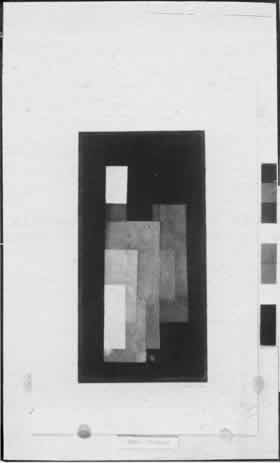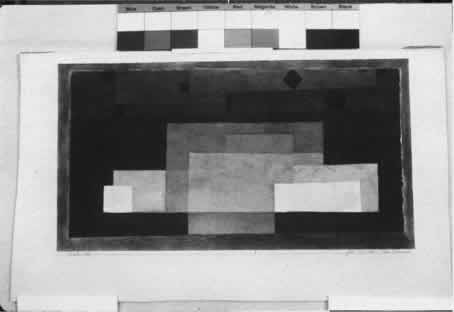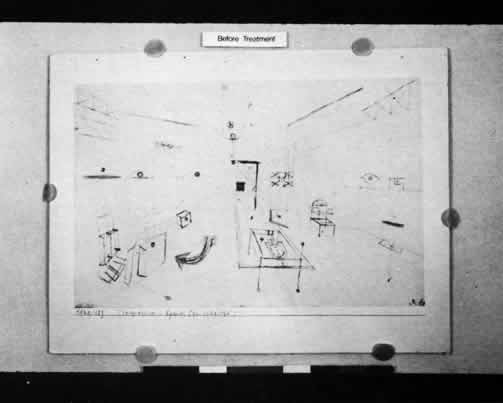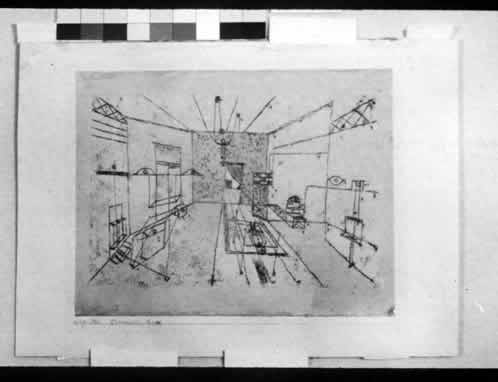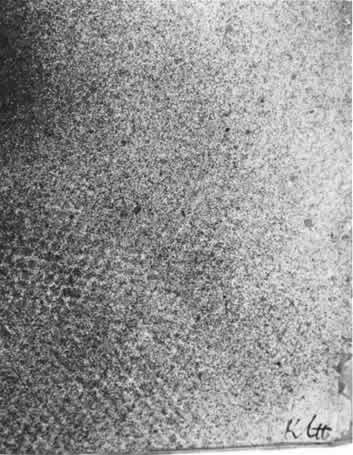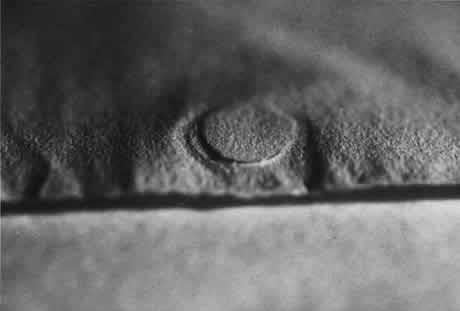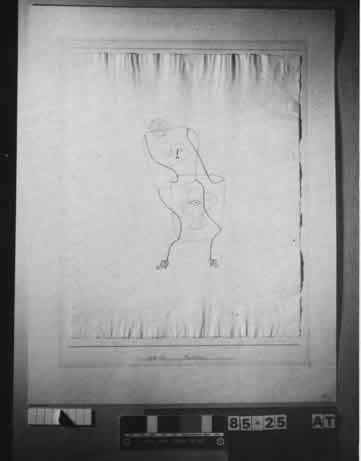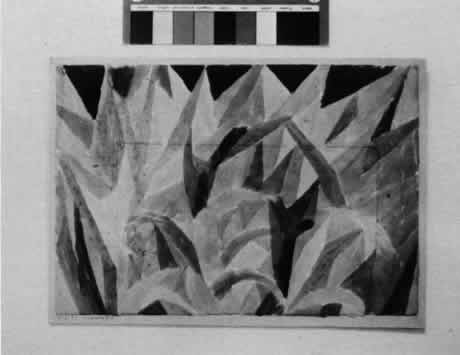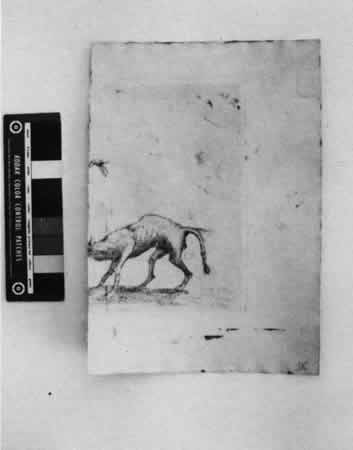An Approach to the Conservation Treatment of Paul Klee Drawings
by Elizabeth Kaiser Schulte, Margaret Holben Ellis, and Antoinette KingIn 1984 the Metropolitan Museum of Art received a gift of ninety Paul Klee paintings, drawings and watercolors.1 Seventy-eight of these are classified as drawings.2 While this collection yielded much information about Klee's unique working procedures, including his often unusual techniques and materials, it also raised some vexing conservation questions. One, in particular, demanded attention—given the compound structure of a typical Klee drawing, how does a conservator determine an appropriate conservation treatment for it?
Soon it became apparent that many fellow conservators had similar concerns over the treatment of so-called "compound" drawings—that is, a drawing mounted by the artist to a—"secondary" support which conveys both aesthetic and historic information. It was decided that a collaborative approach involving several conservators with experience in treating Klee drawings would be the best way to arrive at an answer.
Most people are aware that Paul Klee systematically mounted his drawings on paper to secondary supports of stiff cardstock. Drawings and paintings on bits of burlap, even canvas scavenged from downed WWI airplanes, and other unusual substrates were likewise mounted. Klee began to mount his drawings to secondary supports around 1903 and continued to mount them until his death in 1940; in fact, an unmounted Paul Klee drawing is an exception rather than the rule in his work. So much so, that when a single unmounted sheet is encountered one should immediately examine its verso for tell-tale signs of previous mounting.
While some information is available on Klee's working techniques, scarcely any concerns his drawings as art objects, that is to say, two sheets of paper aesthetically related as well as physically adhered to one another. A quick scan of Klee literature reveals that most authors have been concerned with Klee's images as they relate to his color theories, his symbolism, his interest in poetry, music and nature and his teaching methodology. This lack of information was greatly alleviated by Paul Klee's son, Felix, who answered our questions pertaining to the actual construction and structure of a typical Klee drawing in February 1986.3
Felix Klee's recollections along with a close reading of his father's diaries provided insight into Paul Klee's method of mounting his drawings and what part this procedure played in his daily working routine. In addition, as many Klee drawings were examined as possible, with close attention paid to the drawing (primary support) and its mount (secondary support), their method of attachment, and, most important, the relationship between the two.
This relationship between the primary and secondary supports, obviously, is the first issue to be dealt with before treating any compound work of art. In the case of Klee drawings, four factors contribute to the importance of the secondary supports.
- Starting in 1911 Klee began to systematically record all his
works into a work catalog. By the time of his death over 9000 works
of art in all media were recorded. When he began the work catalog he
also recorded works done prior to that time, for example, a portrait
of his son Felix carries the date of 1908 followed by the catalog
number 73. For each work, Klee entered the date, catalog number,
title and a description of the technique he used. After 1925 he
replaced the numbers with a code combining letters and numbers to
disguise the enormous number of drawings produced in a single year.
Fig. 1
Fig. 2
Klee would mount his drawings to secondary supports which were then inscribed with the date, catalog number and sometimes title. This is what can be considered Klee's standard presentation format (Figures 1 and 2). In this sense, the secondary support serves as a record keeping or informational device. In a broader sense, this scrupulous procedure of mounting and recording his works implies that Klee did not consider them officially finished until he had done so.
His diaries support this idea that the mounting of his drawings was a routine part of his working procedure as well as the final step in their creation. He writes of accumulating ten or more and then mounting them all at once or of setting aside a morning just for mounting watercolors.4 He writes with great satisfaction of immediately framing and hanging a painting on paper with which he was particularly pleased.5 As for his paintings, a visitor to his Dusseldorf studio wrote, ".., a painting ... was complete only when the frame was finished. So it was not merely an 'art object' but a completed totality."6 That the cardstock mounts, as intimately related to the drawings as their frames, should enjoy equal status does not seem unrealistic.
Fig. 3
Fig. 4
Drawings were not necessarily entered into the work catalog chronologically. A brown ink drawing (Figure 3) must have been done before the drawing done by tracing over it (Figure 4), however, its catalog number implies the opposite order of creation. A detail of the original drawing clearly shows the inscribed lines left by the stylus used to trace over it. It would appear that only after a drawing was mounted was it officially entered into Klee's work catalog.
Fig. 5
- In addition to their record keeping role, Klee's secondary supports also served an aesthetic or decorative function. While simple black lines are the most familiar decorative touches, Klee also used bands of colored gouache and ink, strips of gold foil and metallic paint to enhance the presentation of his drawings. In two 1921 watercolors he explored the effects of his current color theories by inserting complementary colored papers below each drawing. A close look at the painted borders of some drawings confirms that the artist mounted the drawings first and then decorated the mount (Figure 5).
- Klee mounted drawings before giving them to dealers for exhibition. The mount was, therefore, the official presentation format for the piece, including its proportions. It would appear that Klee cut each secondary support to complement the size of the drawing. No two are alike, implying that Klee did not choose a convenient standard size. The proportions of the mount, therefore, are intended to enhance the drawing in the same way as the decorative bands which surround it. one can put forward the suggestion that Klee drawings were not meant to be covered up by mats which hide their true proportions nor should they even be put into frames of different dimensions. The idea that the viewer should see the secondary support in full has considerable ramifications when a Klee drawing is reproduced in catalogs or slides. When the piece is cropped to the image only, all indications of the artist's carefully chosen presentation format, not to mention scale, are denied the viewer.
- Finally, Klee mounted his drawings for the very mundane reason of thriftiness. By decorating the mounts and using them as the presentation format, he was able to save money on exhibition costs.
The method Paul Klee used to mount his drawings plays a significant role in their "look" and, to a large extent, determines how they will be treated. As discussed, Paul Klee would routinely mount his drawings as part of his working procedure. Examination of the works indicate that the adhesives most frequently chosen were an animal glue and a starch or flour paste.
Klee's diaries suggest that the artist was content to reach for whatever was on hand, as well. In 1918, while Klee was serving in the German military near Augsberg, he wrote, " I mounted six of my watercolors, right here, and in so doing used up my cardboard (and my official government paste)."7
At home, the routine mounting of drawings was an activity which his son, Felix, remembers well. He recalls how his father would cook white flour to make paste, which he kept in a bowl for one or two days until it spoiled. When he needed more he simply cooked up more. Felix Klee describes his father as both a handyman and a craftsman. His pastemaking, like his meticulously decorated mounts, reflects this nature, but, as his son is quick to point out, it was also one more way for the family to economize.
Drawings were attached to secondary supports generally in two ways:
- in a random or regularly spaced configuration of adhesive dabs, which will be called spot attachment.
- mounted overall with a thin layer of adhesive, which appears most often to be thinned starch paste.
When drawings are mounted by spot attachment, they do not lie flat. In some cases, the undulations which result from spot attachment coincide with the drawing's style and do not interfere with its appreciation. Or the undulations may have come about naturally before the drawing was even mounted, a reasonable assumption when we read in his diaries, "On a misty autumn morning, I spread the large, humid sheets of-Ingres paper out on the gravel in the garden..."8
Some buckling, then, is to be expected, but when aggravated by fluctuations in climatic conditions, the paper's topography is pulled into exaggerated draws and distortions around each adhesive spot. It would seem safe to conjecture that, while some shrinkage of the adhesive occurred upon drying and aging, it is doubtful that the resulting distortions reached the extremes we sometimes see.
Drawings mounted overall remain in plane with their secondary support and generally do not seem to suffer from lifting or bubbling. Klee's meticulousness is reflected in the fact that one rarely sees any adhesive oozing out from below the drawing.
There does not seem to be a reason for the artist choosing spot attachment or overall mounting. Both are used for drawings of similar style and are used interchangeably throughout his lifetime. Whatever the method used, however, the choice certainly affects the final "look" of the piece.
The materials chosen for the secondary support, like the methods used to attach the drawings to them, are consistent throughout Klee's life. While there are some exceptions, by and large drawings are mounted to cardstock. The term "cardstock" was chosen to differentiate this material from cardboard,-which implies a stiffer paper product. Cardstock, or more properly Bristol, is thinner and more flexible.
The cardstock used by Klee is generally of two types:
- a multi-plied board made from laminating several sheets of the same paper.
- a sandwich of two better quality endpapers covering a core of compressed groundwood pulp. This type of board, sometimes called "filled Bristol", is only lightly thicker than the multi-plied type, but is still lightweight and flexible.
In both types the end-papers are slightly or highly polished and generally nonabsorbent.
While conservators today are generally well aware of the importance of keeping Klee's mounts intact, their owners and their owner's framers are unfortunately not. As a consequence, most Paul Klee drawings have fallen prey to the vicissitudes of framing fashions. The most common types of abuse to secondary supports encountered include:
- disfigurement caused by glues, tapes and framers' notations.
- cut down or folded over to fit into smaller frames.
- covered up with poor quality mats causing mat burns.
- removed and disposed of altogether.
Klee's drawings arrive in a conservation laboratory for a variety of reasons—many for the damages described above. A significant number come to a conservator's attention because of disfiguring draws around the adhesive dabs present in spot attached drawings. The extreme tensions set up along the interface between the attached and unattached areas necessitates treatment both for aesthetic and therapeutic reasons. The following case history deals with the treatment of a spot attached drawing.
Fig. 6 - Raking Light
The work, Bauchtanz (Belly Dance), an ink and watercolor drawing with graphite underdrawing, was adhered to its secondary support in eighteen evenly placed spots. Severe draws and cockles, which were quite disfiguring resulted around the points of attachment (Figure 6). The attached areas of paper appeared embossed. The secondary support which had discolored to a pale orange tone also had a prominent mat burn.
The first step in the treatment involved the release of the primary support from the secondary support using steam locally directed to each spot of adhesive. The adhesive released effortlessly, relieving many of the extreme tensions. Draws around adhesive spots reduced, as, to a lesser degree, did the embossment from each adhesive dab. Cockles inherent to the paper, along its upper and lower edges, remained unaltered.
Fig. 7
The decision to remove the drawing from its mount was reinforced when the primary support was turned over. Shearing and delamination of the paper was evidenced around the outer edges of a number of the adhesive dabs (Figure 7). This was visible only on the reverse and is believed to have resulted from extreme tensions and stress created within the paper by the numerous spot attachments. These weakened areas were reinforced either by inserting wheat starch paste between the delaminations or with lightweight Japanese tissue mends applied with wheat starch paste.
Fig. 8
The most difficult decision was not whether to disassemble the work or not, but involved the degree of flattening. How should the work look after treatment? And how was it meant to look? By examining a number of Klee's drawings and discussions with other conservators familiar with Klee's work, the solution was reached. It was decided to retain the overall character of the sheet as well as evidence of past attachment by the artist, that is, the impressions caused by the dabs of adhesive remained while severe distortions were reduced. Consequently, only a minimal attempt was made to reduce the extensive cockling, much of which was either inherent in the sheet beforehand or was a direct and immediate result of the artist's technique. This was accomplished by the most gentle form of humidification. The primary support was placed in a slightly humid room followed by placing it between soft felts under glass. The effect was minimal but this step, in conjunction with the relaxation of draws and tensions that took place during removal from the mount, served to reduce distracting distortions without affecting the overall character of the sheet which seems closer to the artist's original intent (Figure 8).
The primary support was hinged along all four edges in its original position to the secondary support with Japanese paper and wheat starch paste. A thin sheet of slightly buffered compatible Japanese paper was hinged to the mount underneath the primary support to provide an isolating layer between the discolored secondary support and the drawing, even though the secondary support was not discolored under the primary support.
In this particular instance, the work was placed in a window mat for exhibition purposes. Because Klee appears to have determined the proportions of the mount by its relation to the drawing, it would have been preferable to show all of it by using ragboard lined plexiglas spacers to isolate the work from the glazing instead of a window mat. Unfortunately, a mat burn disfigured this mount preventing the showing of the entire sheet. Ink solubilities of the inscription on the secondary support precluded aqueous treatment.
Drawings that Klee entirely adhered to their secondary supports also arrive at labs for treatment. The treatment that is undertaken often involves the removal of the work from the secondary support. Probably the most overriding concern and reason for disassembling these mounted pieces is the fear of acid migration and subsequent deterioration of the drawing. An extension of this rationale applies to the use of interleaving sheets.
Fig. 9
Fig. 10
The watercolor entitled Wachsendegras (Watching the Grass Grow) (Figure 9) was removed from its secondary support to which it was entirely adhered in order to isolate it from and treat its secondary support. Klee often used the reverses of older works of art for his drawings especially during WWI when he was in military service. In this particular work dated 1917, he painted on one half of the reverse on an earlier intaglio print. The L-shaped indentation is the platemark that appears darker because of the pooled watercolor. He incorporated foxing that existed in the print into the design as stoma-like marks on the blades of grass. Once removed from its secondary support, the etching done by Klee in 1903, entitled Weib and Tier I (Woman and Animal I) was revealed on the reverse (Figure 10). Upon treatment completion, the watercolor was interleaved and hinged to the secondary support around its edges. Its appearance was virtually identical to the work prior to treatment.
At the time of this treatment, separation of the primary from the secondary support was viewed as necessary for its long term preservation. It is questionable, though, that this treatment would be repeated, i.e., the disassembling of a compound drawing, for the following reason. There is no evidence that the mount is actually causing damage to the primary support. The presence of another work on the reverse is really not justification to warrant its removal.
After looking at a large number of Klee works that have been either spot attached or overall mounted, none seem to have suffered from acid migration. Perhaps this can be attributed to the overall better quality and surface preparation of the endpapers of the cardstock which act as physical barriers. This idea is supported by the observation that the versos of the drawings (where it was possible to examine them) have not been discolored from being in prolonged contact with their cardstock mounts.
A phenomenon frequently encountered is the situation where the area of the secondary support protected from light by the drawing is lighter than its exposed borders. It would appear that UV radiation dramatically increases discoloration by catalysing the degradation of certain components within the cardstock. It seems logical to suggest that when UV radiation is masked out by the drawing and, thus, prevented from striking the cardstock below, chemical reactions leading to its discoloration and embrittlement are significantly lessened.
While the rationale that dismantling compound drawings for protective and preventative reasons is valid, based upon our observations, such a procedure should not be routine for Klee's drawings. The only reason then to dismantle these works would be because of physical damage and extremely disfiguring distortions caused by tensions in spot attachment, such as the type seen in Bauchtanz.
When proposing a treatment for a Klee drawing, it is necessary to consider the following factors before making treatment decisions:
- Klee's drawings are compound works of art. The secondary support is an integral part of the work. An aesthetic message is sent to the viewer by its size, its decorations and its inscriptions. In addition, it provides historic evidence not only of Klee's working procedure but of his family's financial situation as well. As a routine part in the creation of the piece, the secondary support can be seen as similar to an epreuve d'artist, the artist's gesture of completion.
- Klee often used unorthodox papers, for example discarded etchings, old prints, newspaper pages or combinations of papers. In fact, it would appear that the papers of the drawings themselves are often more problematic than the cardstock to which they are mounted. Foxed and cockled papers were sometimes purposefully chosen by the artist and incorporated into the design. The dot patterns of spot attachment as well as the cockled almost ruffled edges of some of his papers were a direct result of the artist's technique and had to have been accepted by him.
- The typical mount does not appear to cause deterioration of the primary support. The adhesives also do not seem to promote deterioration. The localized tensions, however, that develop around adhesive spots do cause damage in some instances. Fluctuations in environment aggravate this problem, causing additional or more severe distortions.
When it comes to complex constructions such as Klee drawings, there is great value in collaboration and consultation with other conservators. The subtleties of Klee drawings and the impact of their treatment become much more obvious when comparing a group than when dealing with an isolated example. The importance of seeing a large collection of an artist's work is pivotal to our understanding of how the works should look. At first glance, one might naturally think that spot adhered drawings would look better if they were flatter or that any drawing adhered to a nonarchival secondary support should be immediately disassembled.
There are over 5,000 cataloged Klee drawings, a large number of which are in this country. As a rule of thumb, minimal treatment, proper housing and exhibition, in particular reducing exposure to UV radiation, lessen the potential for problems and leave the work closer to the artist's original intent.9
Notes
1. A generous gift of Mr. Heinz Berggruen.
2. A broad definition of drawing encompassing pencil, ink, gouache, watercolor, oil paint and transfer drawings on paper or cloth, all mounted to secondary cardstock supports.
3. Sabine Rewald, Assistant Curator, The Metropolitan Museum of Art, graciously agreed to convey our questions to Felix Klee and helped in the interpretation of his answers.
4. Paul Klee. The Diaries of Paul Klee 1898-1918. Ed. Felix Klee. Berkeley: The University of California, 1964, p.398.
6. Norbert Lynton. Klee. London: The Hamlyn Publishing Group, Ltd, 1964, p. 83.
9. The authors would like thank Debra Mayer, Martina Yamin and David Chandler for their collaboration.
Elizabeth Kaiser SchulteSenior Conservator
Conservation Center for Art and Historic Artifacts
Margaret Holben Ellis
Associate Conservator of Prints and Drawings
The Metropolitan Museum of Art
Antoinette King
Director of Conservation
The Museum of Modern Art
